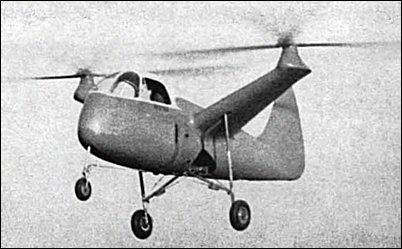
| Landgraf Model H-2 1818 |  |
 |

| Landgraf Model H-2 1818 |  |
 |
|
The Landgraf Helicopter Company of Los Angeles, California, is also engaged in building a single-seater cabin helicopter. President of the company is Fred Landgraf, an aeronautical engineer formerly employed by the Douglas Aircraft Company, El Segundo Division. The Landgraf helicopter resembles the Army Platt-LePage XR-1, but it is much smaller and its control principles are entirely different. The fuselage of the craft is about 4m in length. It is very much like a conventional airplane in shape, including a rudder very similar to the vertical rudder on a P-47 fighter plane. The fuselage is built entirely of wood. Horizontal pylons, also of wood, for rotor mountings, extend outward from the fuselage about midway between nose and tail. The craft has a tricycle landing gear, two conventional wheels and a nose wheel. The wheels are all retractable into fuselage and pylons. The two rotors, each with three blades, rotate in opposite directions around pivotal points at the outward tips of the pylons. These rotors, whose disks of rotation are 5.5m in diameter, intermesh, as the hubs are only 3.6m apart. The blades of the rotors are unusual in their design. Built entirely of wood, the shells of the blades, shaped as airfoils, rotate about the spars. This rotation is actuated by small ailerons at the tips of the blades. H.F.Gregory "Anything a Horse Can Do. The story of the Helicopter", 1944
Fred Landgraf established the Landgraf Helicopter Corporation in the early years of the War, and flew a prototype of his single seat Landgraf H-2 as a development machine for a series of three-seat (H-3) and 5/8 passenger helicopters (H-4). The Landgraf concept involved twin outrigged rotor pylons carrying three-bladed wooden rotors, which were fitted with ailerons to allow the direction of travel of the machine to be changed. The all-wood H-2 first flew on 2 November 1944, powered by an 85hp Pobjoy R engine. Testing of the H-2 continued until 1949 but withdrawal of military funds resulted in the demise of the Landgraf company. They did, however, grant rights to Firth Helicopters Ltd in England and they built the prototype Firth Helicopter using the fuselage of the Planet Satellite light aircraft. This machine (G-ALXP) was built in 1954 but never flew. R.Simpson "Airlife's Helicopter and Rotorcraft", 1998
Experimental single-seat twin-rotor helicopter powered by a Pobjoy R radial engine. First flown on 2 November 1944. In 1945 the company received a contract from the US Army for development of the helicopter. M.Taylor "Jane's Encyclopedia of Aviation", 1989 * * * The single-place twin rotor Landgraf helicopter flown in 1946 was a hingeless rotor blade helicopter which was awaeded a design study contract by the U.S. Air Corps. Its 4.8-meter rotors were powered with an 85-horsepower engine, and it had a cruising speed of 110km/h.
|